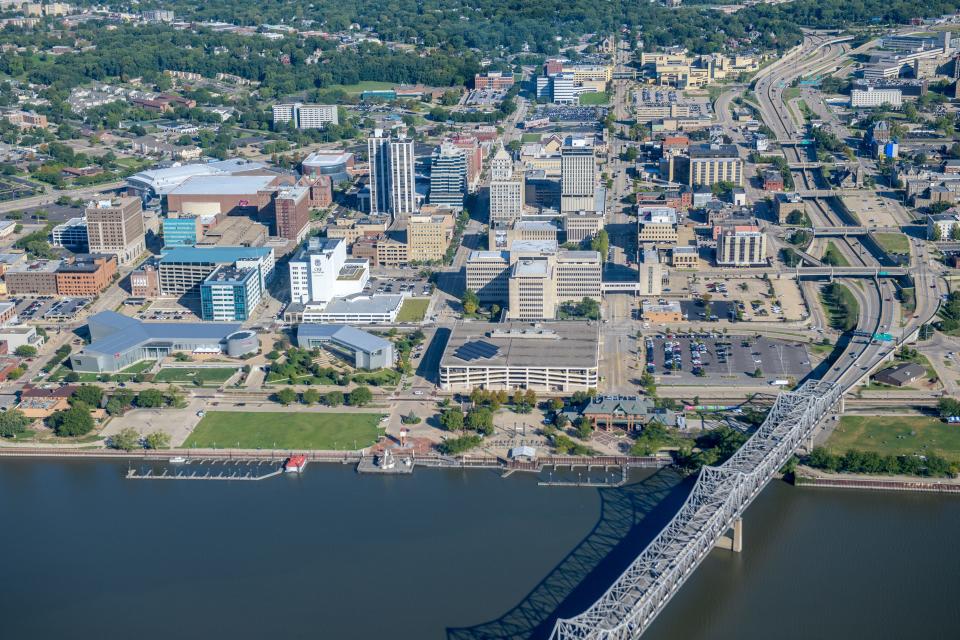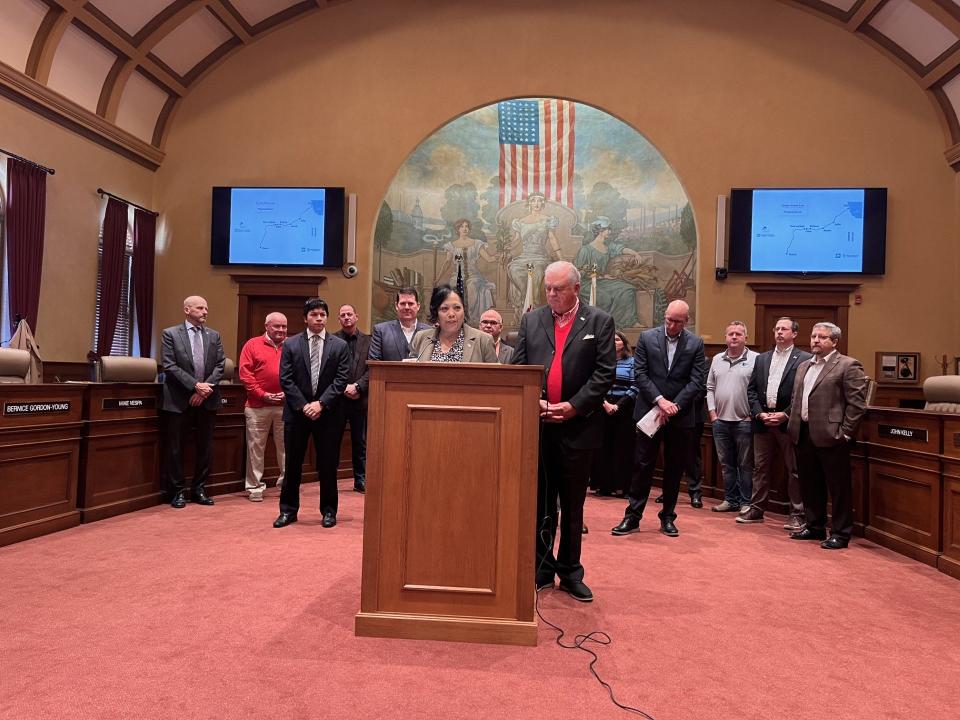What is the future of Downtown Peoria? Here's the vision
PEORIA – No part of this city has exemplified its highs and mirrored its lows like Downtown Peoria.
When the River City was booming, rich with manufacturing and growth, so too was its downtown − once a hub for shopping and socialization.
When Caterpillar stunned Peoria in 2017 and moved its headquarters out of the city after promising to build state-of-the-art new headquarters here, it was Downtown Peoria that took the brunt of the fallout.
In 2020, when the COVID-19 pandemic upended life, it was Downtown Peoria that saw its thousands of office workers disappear, leaving major buildings vacant and a business scene reeling.
Downtown Peoria, also known as the Central Business District, goes as the rest of the city goes, meeting it at both its peaks and valleys.
These days, Peoria is a city at a crossroads, a town striving for growth and battling crime and poverty that have long lingered here.
Downtown Peoria, too, is at a crossroads. Businesses have reappeared years after the pandemic shuttered many storefronts. And there is hope some empty office spaces may be converted to residential living spaces.
A hole once left by Caterpillar's broken promise has been partially filled with OSF HealthCare's new headquarters on Adams Street, which is home to several hundred workers on any given day. The Peoria Civic Center also remains a busy staple of the Central Business District.
As downtown awaits revitalization, local leaders have a vision to make it a thriving hub for the city once again. This vision is backed by tens of millions of dollars in state government investment and strong efforts to attract business and innovation.
More: Peoria unveils multi-million dollar plan to overhaul its riverfront. Here are the details
The Peoria riverfront has '21st century opportunities'

More than $50 million is coming to Downtown Peoria for two major projects: a $25 million facelift of Main Street and a $26 million makeover planned for a completely new riverfront. Of that $51 million, $40 million is state money, although the city is still waiting on $11 million for the riverfront.
Both projects promise to be significant upgrades, but the riverfront makeover in particular is one that city leaders hope can transform downtown in a major way.
Kimberly McGhee, a member of Peoria's Downtown Advisory Commission, said the riverfront is a "huge" part of the city's identity.
"We are the River City," McGhee said.
State Rep. Jehan Gordon-Booth secured money for the riverfront, envisioning "21st century opportunities." She hammered home the idea that younger generations need things like riverfront amenities to stay satisfied in a city.
She said the current riverfront is "pretty but not fully actualized." In order to grow downtown into a place that will attract a younger crowd and keep it viable for those who already live here, Gordon-Booth said Peoria has to invest in people and infrastructure.
"Without people, the infrastructure means nothing. ... The infrastructure, though, is critical," she said.
More: Childers unveils new look of Gateway Building in Peoria
What does the future of Peoria look like?
Peoria Mayor Rita Ali envisions a new riverfront as a hub for activity in Downtown Peoria. She would like to see rental bicycles, a new riverboat and more features to address the needs of young people, along with what's already included in the new riverfront plan.
The plan will include a dog park, sports courts, a fitness area, a kayak launch and a barge park on the water. Those amenities are a huge part of the overall vision for growing downtown, but there is still more work to do.
Gordon-Booth and Ali said shopping and dining experiences will be major factors in revitalizing downtown. Gordon-Booth also said "pop-up" experiences on the riverfront, like those provided by the Peoria Park District and Peoria Riverfront Museum, will play a key role.
"One of the least tapped places is our riverfront," Gordon-Booth said.
Ali, 65, remembers as a child in the 1960s and '70s taking the bus from her home in South Peoria to visit downtown frequently. Back then, it was the hub for shopping and socialization in the city. McGhee, too, remembers spending a lot of time during her childhood on the riverfront and downtown.
Ali and McGhee said when Northwoods Mall opened in 1973, downtown took a hit. It continued the trend of losing stores as shopping destinations moved north. But these new plans and hopes could restore some of what was lost.
For Gordon-Booth, there is no vision for Downtown Peoria that is too big.
"When you think about what you want in the community, there is a vision about what would a fully actualized, fully built-out, the dopest Peoria you can dream of ... that does not exist without a downtown riverfront that is not incredible," Gordon-Booth said.
More: Luxury residences and a rooftop pool planned for Peoria's riverfront. Here's what we know
An Amtrak dream for Downtown Peoria

Downtown Peoria and the riverfront could be entirely transformed if Ali's biggest wish for Peoria comes true: Amtrak coming to the city.
Ali's pursuit of passenger rail for Peoria has been well documented. She has pushed hard to find ways to include city, state and federal dollars for the project.
Ali and Gordon-Booth noted that billions would be needed to bring passenger rail to Downtown Peoria. But it is an investment Ali thinks is well worth the cost and effort.
"It will be a game changer," Ali said.
Peoria's downtown post office and riverfront Gateway Building are two potential sites for an Amtrak station. Either location would drastically change the makeup of the Central Business District.
The proposed rail line would connect downtown Peoria to Chicago, Joliet, Morris, Ottawa and LaSalle-Peru. Ali said she thinks this would entice more people to visit Peoria, bringing a boost to the economy with it.
But the plan likely would not be completed within the next 10 years. It is by any estimation a long-term proposal.
Gordon-Booth said she is "super excited" about the work being done on train service but said the work "has to continue" and be consistent to keep the hope alive because she says Peoria "absolutely needs it."
"I've been around the process long enough to know that rail doesn't happen in two or three years," Gordon-Booth said. "Rail takes a long time and it takes a ton of money from the federal government, a lot of money from the state, a lot of money from the city. You need a government fully bought into making it happen."
Most of those same things could be said about revitalizing Downtown Peoria.
More: Main Street in Downtown Peoria is promising and problematic
This article originally appeared on Journal Star: With Peoria at a crossroads, city leaders dream of flourishing downtown

